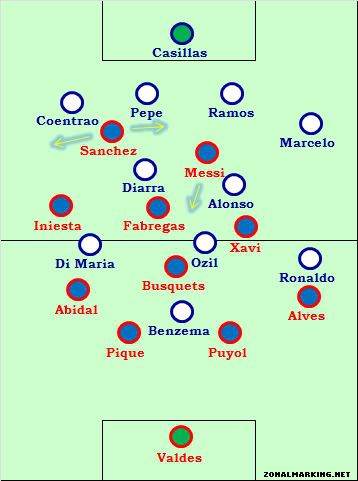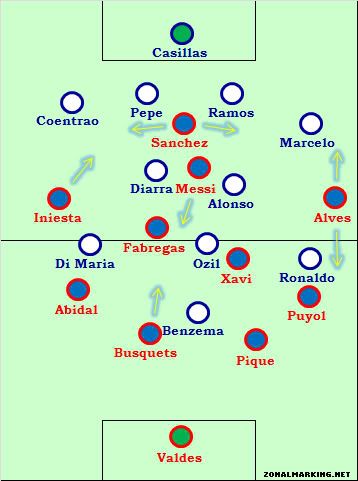|
|
此文章由 团结的腹肌 原创或转贴,不代表本站立场和观点,版权归 oursteps.com.au 和作者 团结的腹肌 所有!转贴必须注明作者、出处和本声明,并保持内容完整
http://www.zonalmarking.net/2011/12/11/real-madrid-1-3-barcelona-tactics/
Real Madrid 1-3 Barcelona: Real press early on, but tactical switch gives Barca the upper hand December 11, 2011
 The starting line-ups The starting line-ups
Jose Mourinho surprised many with his team selection, but Pep Guardiola adapted to guide Barcelona to victory.
The surprise was with the use of Mesut Ozil, who most expected to be omitted in favour of an extra defensive midfielder. In fact, it was Real’s usual front four in a 4-2-3-1 system. Lassana Diarra did start, but in place of Khedira, whilst Fabio Coentrao played at right-back.
Guardiola had faith in the fitness of Gerard Pique and Carles Puyol, and dropped Javier Mascherano. He went with Cesc Fabregas and Alexis Sanchez further forward.
Question number one in the preview was ‘Will Real press?’ – a question that was answered emphatically within the first thirty seconds. Barcelona tried to play out from the back, Victor Valdes got his pass wrong, and Benzema fired home for the earliest goal in Clasico history.
Pressing and Ozil
That was the best possible start for the home side, and Real’s pressing was, as expected, most obvious in the first 20-30 minutes of the match. They prevented Barca from constructing good moves from the back, although the Barcelona defence admirably remained committed to passing football throughout the match.
However, it was notable that Real’s attacking band of three had little impact when they won, even when given opportunities on the ball. Cristiano Ronaldo was a peripheral figure, Ozil created little and was removed early in the second half, Di Maria battled well but his end product was often poor. By asking his attacking players to work extremely hard without the ball, maybe Mourinho drained them of the energy they needed when attacking.
The big decision, the use of Ozil, was unsuccessful. Although he he saw a fair amount of the ball in the first half, he rarely played a key pass. Without the ball, he always seemed a couple of yards too slow to close down, and Real could have done with an extra holding player to congest the centre of the pitch – Messi came deep and got too much room.
Barcelona starting shape
Even taking into account the inevitable fluidity, Barcelona’s starting line-up was difficult to decipher. Taking the 4-3-3 as a base, Andres Iniesta was wider than usual, Messi was more of a number ten than a false nine, Cesc Fabregas wasn’t part of the forward line at all (as he often has been this season) but tucked into midfield and seemingly not really knowing what his job was, whilst Alexis Sanchez started on the left but made diagonal runs across the pitch into a centre-forward position.
The approach was reminiscent of the formation Guardiola used in Barcelona’s 2-0 win at the Bernabeu in April 2010, when he used Messi deep and right-of-centre, and Pedro Rodriguez as a left-sided forward. Sanchez did particularly well to occupy both centre-backs and often Coentrao too – with Iniesta always coming from deeper to try and overload the Portuguese full-back.
 After around 20 minutes Guardiola switched players around After around 20 minutes Guardiola switched players around
Barcelona
And, perhaps recalling that 2-0 win, Guardiola moved his side even further towards that system after around 20 minutes. He ordered Dani Alves forward to a right-wing position, Carles Puyol out to right-back, Gerard Pique moved across, and Sergio Busquets dropped to left centre-back. Fabregas moved deeper to help out in midfield, and Barcelona were broadly 4-4-1-1.
The precise reason he decided upon this change is unclear, but it had various benefits:
1) It meant that Busquets, identified as key in the preview of the match because of his ability to prompt good attacking moves, was away from the press of Ozil and could start to feed balls into midfield. He also bravely continued to step out of the back when Barcelona attacked – he got tight to Ozil so Xavi could move forward to the edge of the box.
2) Ronaldo had been a threat early on with a couple of decent chances, but by putting Puyol on him, and often doubling up with both Puyol and Pique (plus the occasional help of Alves), Guardiola almost completely nullified Ronaldo’s threat. Ronaldo had a very quiet game, and Mourinho tried to spark him into life by moving him to the right in the second half, summing up how effective Guardiola’s change had been.
3) It gave Barcelona more width with the use of Alves, something that was desperately lacking in the early stages. He enjoyed the large amount of space between Marcelo and Ronaldo and was constantly an out-ball on the break, most obviously getting down the flank to cross for Fabregas’ header, the third goal.
4) Least crucially, but nevertheless a factor, Fabregas dropped deeper and seemed to know what he was doing more, particularly in the second half.
It was after the switch that Ozil really should have had more of an impact – there was theoretically plenty of space between the lines for him, but Busquets continued to close him down and prevented him being key in the transitions. As the average position diagram shows, even in the second half when part of the back four, he often moved up much higher than the other three defenders, so there was an element of Guardiola’s three-man defence.
Messi
Unlike in the Supercup when Mourinho ordered Ricardo Carvalho to stick tight to Messi, this time he went free. There was a good reason for the centre-backs staying in place – Messi was playing as a number ten (and often even deeper than that) rather than a false nine, but with Diarra and Alonso taking on Fabregas and Xavi in the centre, it meant Messi often got an amazing amount of time on the ball, despite a good battling performance from Diarra.
 Barcelona's average positions in each half. Source: Opta's @OptaJose twitter account Barcelona's average positions in each half. Source: Opta's @OptaJose twitter account
For the first goal Messi was able to pick up speed before beating both Alonso and Diarra and slipping the ball through for Sanchez, for the third he passes the ball out to Alves on the break after receiving the ball in space. For all the other tactical factors in this match, Messi not being accounted for was very important. He simply got too much room.
Latter stages and changes
Real were extremely unfortunate with the second goal, but the third seemed to kill the game, even after 66 minutes. Mourinho’s side went flat and Barcelona now became focused upon ball retention. This was probably the stage when Real were hoping to sit deep and remain compact (whether winning or drawing) but with a two goal deficit they had to be more proactive.
Kaka had already replaced Ozil (and did OK), the other changes saw Khedira on for Diarra after the Frenchman had been booked, and then Gonzalo Higuain on for Di Maria, who had probably contributed more than Ronaldo. Higuain went upfront and Benzema went left, going close on one occasion after beating Puyol. The changes weren’t particularly inspired, but they did give Real extra energy.
Barcelona slowed the tempo of the game well, and could have added a fourth on the break. Guardiola’s changes were all after 80 minutes and all roughly like-for-like – Seydou Keita, David Villa and Pedro all came on, but the game changed little with their introduction.
Conclusion
Mourinho has often been criticized for not being brave enough against Barcelona – but here he went with an attack-minded side featuring his usual front four, and also looked to press from the front early on. The pressing broadly worked, the use of Ozil broadly didn’t.
The minimal benefit Real gained from playing a central attacking playmaker was more than cancelled out by the amount of space Messi often found; space he surely wouldn’t have enjoyed had Real played an extra (more defensive-minded) midfield player. It’s impossible to know if the alternative formation would have worked – and it might have meant space for another Barcelona elsewhere on the pitch, but giving space to any other player is preferable to allowing Messi to thrive.
Mourinho will point to elements of bad luck, and the fact that Guardiola needed to change formation for Barcelona to exert dominance. But Guardiola did so successfully, and Real didn’t counter-adapt. The Barcelona players who changed position all had excellent games – Busquets played the centre-half role superbly well, a job few other players could do; Puyol was seldom beaten by Ronaldo in one-on-one situations, and Alves motoring up and down the right was crucial in the second period. A tactical victory for Guardiola. |
|
 搬家之一波三折 (2005-5-3) leeshine
搬家之一波三折 (2005-5-3) leeshine  2010六月法意希游记 ( OK 83楼添加威尼斯 8月19日更新 ) (2010-7-1) garysu
2010六月法意希游记 ( OK 83楼添加威尼斯 8月19日更新 ) (2010-7-1) garysu  【狸狸の私房菜】 之 【老北京褡裢火烧】 ---- 最最最容易做的有肉肉的火烧~~~多图分步带你做~~ (2012-2-28) 黑芝麻狐儿
【狸狸の私房菜】 之 【老北京褡裢火烧】 ---- 最最最容易做的有肉肉的火烧~~~多图分步带你做~~ (2012-2-28) 黑芝麻狐儿  Puffing Billy半日游 (2007-4-26) poloand
Puffing Billy半日游 (2007-4-26) poloand